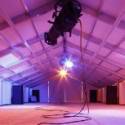
Upon entering an art fair – one of such dimensions as Frieze – I always feel overwhelmed by the impressive amount of (exceedingly expensive) artworks, displayed like luxury items in ordered rows of booths. Also, fair architectures sometimes induce in you, the viewer, that sense of soporific disorientation that makes you constantly feel lost. Both these traits have characterized the thirteenth edition of Frieze London, the second (after Art Basel) largest contemporary art fair in Europe, directed this year by Victoria Siddall.
Hosting more than 160 galleries from almost 30 countries, Frieze 2015 was structured into three sections. The main one including the most powerful and renowned; “Focus”, devoted to young and experimental galleries; and “Live”, hosting performance and participatory works (which debuted last year).
A few stands this year were designed by London architecture firm Universal Design Studio. While David Zwirner and Lisson attempted to catch the collectors’ attention presenting major works by Yayoi Kusama (Zwirner), Anish Kapoor and Lawrence Weiner (Lisson), Galerie Buchholz lured the naïve visitor with a humongous inflatable dummy of Felix The Cat by Mark Leckey and Massimo De Carlo with a Carsten Holler’s majestic pink insect attached to the wall.
Frieze 2015 was elegant in terms of appearance and conservative in terms of content. Lots of large-scale paintings: London Victoria Miro had a few Abstract-Expressionist-like Secundino Hernández pieces, while Los Angeles David Kordansky opted for a solo presentation of Mary Weatherford’s neon paintings; large painted works by Günther Förg, Jacqueline Humphries and Sophie von Hollerman filled the walls of the Greene Naftali’s booth, whereas two impressive canvases by Pietro Roccasalva were featured by Antwerp Zeno X.

If painting predominated, video works lacked (a nice exception were the 16mm films by Amy Siegel at Simon Preston Gallery). Sculpture was eminently represented by Hauser & Wirth, whose large booth was occupied by grey plinths supporting works by big names like Paul McCarthy, Phyllida Barlow and Louise Bourgeois.
Gagosian featured a solo show of astonishing drawings and sculptures by British artist Glenn Brown, while London The Sunday Painter (for the first time at Frieze) showcased just a single work by Samara Scott: a pool in the floor, filled with water and a combination of Lenor fabric softener, cooking oil, wax, food and other detritus (the London artist has fascinatingly described her works as “trembling, putrid glitter, like the sewers of a tranny club”).
Brazilian delegation was formed by São Paulo Galeria Luisa Strina (showcasing, among the others, beautiful collages by Rauschenberg), Fortes Villaça (with works by Damian Ortega and Gusmao + Paiva), the young Galeria Jacqueline Martins and Rio de Janeiro A Gentil Carioca. One of the most interesting booths in the fair was the Mendes Wood DM one, which included sculptures by Neil Beloufa, Daniel Steegman Mangrané and Adriano Costa – a work by the latter was a mirroring chessboard-like floor sculpture.
Two Frieze Projects works offered an escape (or rest) to exhausted curators and collectors: AYR’s Comfort Zone consisted in a series of pastel-hued rooms equipped with double beds and plugs for recharging phones, while Jeremy Herbert’s wide tunnel structure brought the visitors to the cavernous space underneath the Frieze tent, amongst the scaffolding that supported it.

Deixe um comentário